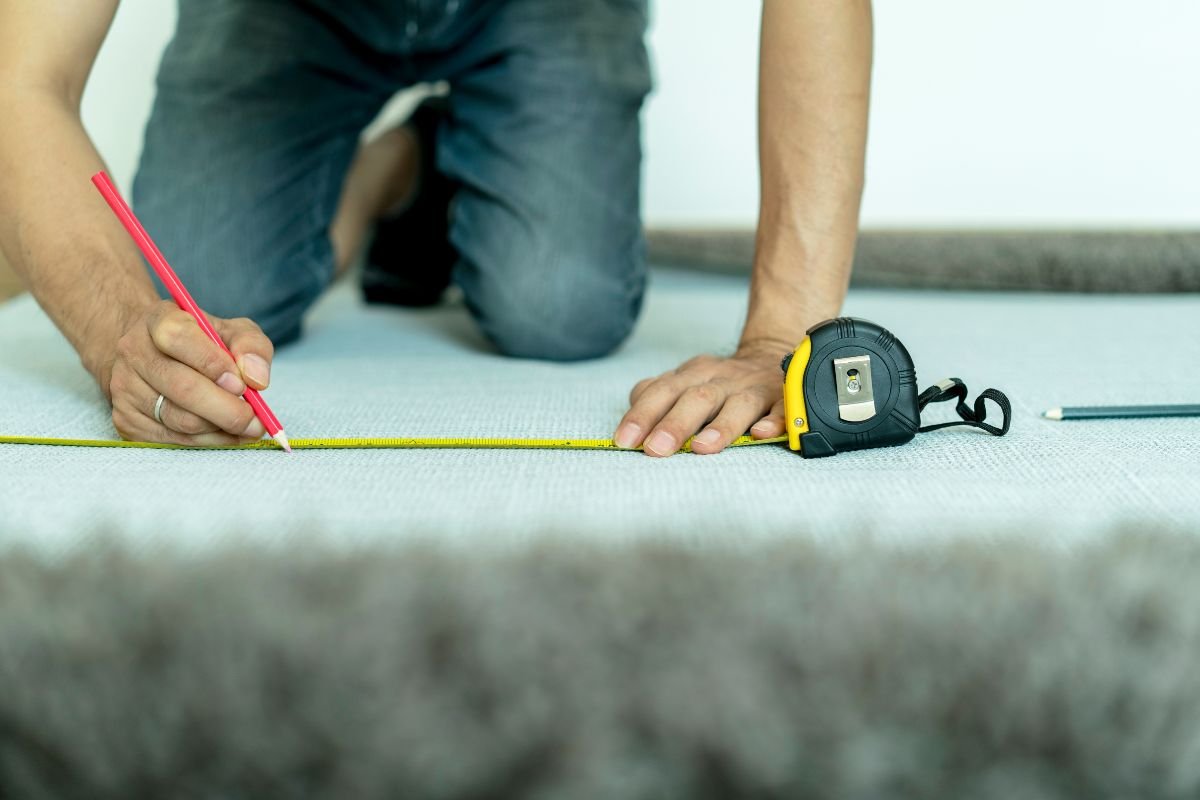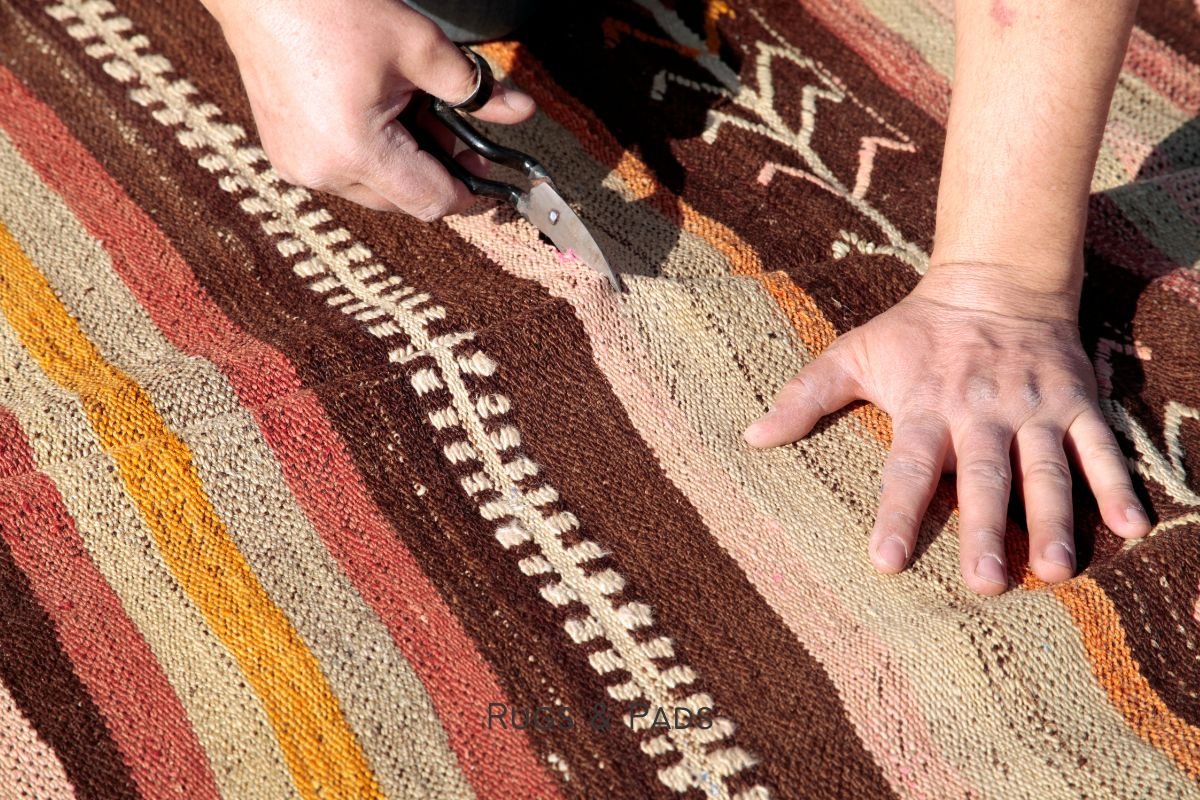This fun DIY project lets us bring to life an old area rug or carpet. The key to it being a fun DIY project and not an ongoing hassle is to seal the carpet edges of your cut carpet or rug and prevent fraying.
That will make it last for a long time.
Although professional carpet binding is far superior to anything I will cover in this post, the tips I’ll go through here will get the job done quickly (and cheaply).
Learn how to cut a rug without it fraying so that you can customize the rugs and carpets in your space.
What Is the Process of Rug Cutting and Binding?
The best (and only) way to prevent frayed edges when cutting rugs or carpets is to bind the carpet edges. When you bind carpet edges, binding tape is sewn over the cut edges to protect the fibers from fraying. This process usually requires a sewing machine and a proficient understanding of how to use a sewing machine. For this reason, many people hire a professional carpet binder to complete the task.
If you’re looking for a quick DIY project, however, then you can follow the steps below.
How To Resize A Rug
Give your tired rug a fresh start by cutting it to the size you want. Overall, this is a pretty straightforward task, though it does require patience and attention to detail. The final result will make you pretty darn proud.
Tools and materials you’ll need:
- carpet knife or utility knife
- carpet binding tape
- hot glue gun
- straight edge
- marker
- measuring tape
- carpet shears (for thicker rugs)

Take Your Measurements
Measure your space and determine how many feet of binding tape you’ll need. You’ll need enough to go around the perimeter of the rug plus a few extra inches for overlap. Make note of the dimensions of the area where you will place your cut rug. You will be using these dimensions to mark your cuts.
Mark Your Cuts
Once you’ve determined your desired size, turn your rug upside down and mark the dimensions on the carpet backing using a straightedge and a marker. Be sure to mark a straight line 😉
Cut The Rug
This part is fairly simple. Using a carpeting or utility knife, score the rug according to your markings. If you’re using a utility knife, then make sure to use a straight edge as a guide. Cut slowly and as precisely as possible to ensure a neat edge. For thin rugs and carpets, the utility knife may be able to make the cuts. If you have a thicker rug or carpet, then you may need carpet shears to complete the cutting. Trim the excess carpet and frayed edges from the perimeter of the rug with a sharp pair of fabric scissors.
Seal the edges
Once the rug is cut, it’s time to secure the edges by taping them down. Rug binding tape is a great way to keep the edges of your rug from fraying and a long-lasting binding style. Simply lay the tape down along the carpet edge, making sure to cover all of the loose fibers. Using a sewing machine, sew the binding tape in place. This will help to secure the edges and keep them from unraveling.
Some choose to tape the cut edges to the recently removed binding, if there was any on your chosen piece of rug or carpet.
If you are not hiring professional carpet binding and you do not have another binding to attach to your cut edges, then you can seal the fresh cuts to prevent frayed carpet edges down the road. There are a few ways to do this:
- Clear glue (like gorilla glue): You can paint clear glue along the edges to seal the cutting. Wipe excess glue off and allow it to dry while lying flat.
- Heat: You can use a heat machine (like an embossing machine) or a flame to heat the edges of your cutting. The heat seals the edges, preventing them from fraying.
- Hot glue gun + Instabind: If using Instabind, then use a hot glue gun to glue the Instabind along the edges. Work quickly, allowing the hot glue to cool with each application. Cut the Instabind at a 45 degree angle on the corners to finish it off.
How To Keep Rug Edges From Fraying
When it comes to preventing frayed edges, every little bit counts. Just as there are many methods to bind carpet edges, there are also many methods to prevent fraying to begin with.
Cut-off loosened rug fibers before they become frayed
One of the easiest ways to keep your rug from fraying is to cut off any loose fibers before they become tangled. Use a pair of sharp fabric scissors to snip away any loose fibers as soon as you spot them. This will help keep your rug looking neat and tidy.
Use an anti-fray agent to seal fibers in place
Anti-fray agents are a great way to keep your rug from fraying. Simply apply a thin layer of the agent to the edges and the fabric fibers will be sealed in place. They come in sprays and thin liquids which can be applied with a brush or sponge.
Seal the edges with heat
Sealing your rug’s edges with heat is a great way to keep them from fraying. Use a handheld heat gun, blow torch, or iron to seal the fibers in place. It’s important to be careful when applying heat as too much can damage the fabric fibers.
Use an all natural rubber rug pad
One of my favorite ways to protect area rugs and carpets from frayed edges (and lots of other problems, to be honest) is with an all natural rubber rug pad. The natural rubber will keep your rug secure to the floor, softening the blow of everyday wear and tear. Natural rubber material also gets along with other materials, such as different types of flooring. Natural rubber does not have any synthetic plastic and is safe to use with any type of tile, wood, or laminate flooring.
Closing Thoughts
Move your rugs from room to room, cutting them down to size with each new iteration of its life. Even with a clean cut, however, your carpet edge may begin to fray after a few months (or God forbid, a few days). My top recommendation is to figure out some sort of carpet binder so that fraying doesn’t occur.








